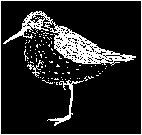| |
|
What are Shorebirds?
Behavior
 One of the most notable and beautiful characteristics of shorebirds is a particular behavioral adaptation - scattered feeders lift off and swiftly consolidate into a graceful flock at the approach of a predator. Each individual's chance of avoiding being eaten is then increased. Some shorebird species are generally solitary, but most will readily join a flock in response to a disturbance. Mixed-species flocks are common. Mixed flocks also make birdwatching more fun for the beginner, who can use contrasts of size, color, or behavior to spot different species.
One of the most notable and beautiful characteristics of shorebirds is a particular behavioral adaptation - scattered feeders lift off and swiftly consolidate into a graceful flock at the approach of a predator. Each individual's chance of avoiding being eaten is then increased. Some shorebird species are generally solitary, but most will readily join a flock in response to a disturbance. Mixed-species flocks are common. Mixed flocks also make birdwatching more fun for the beginner, who can use contrasts of size, color, or behavior to spot different species.
 During the breeding season, shorebird pairs defend territories. In the following lessons, we will learn more about how and why they do that. Individuals of some species also defend mobile feeding "territories" around their moving bodies as they forage during the winter.
During the breeding season, shorebird pairs defend territories. In the following lessons, we will learn more about how and why they do that. Individuals of some species also defend mobile feeding "territories" around their moving bodies as they forage during the winter.
Another distinctive behavioral adaptation of shorebirds is their one-legged posture while roosting. Keeping one leg and the bill tucked under the body feathers conserves heat, an important consideration in the often chilly open areas of their habitat.
|
|
|
|

